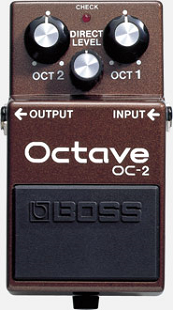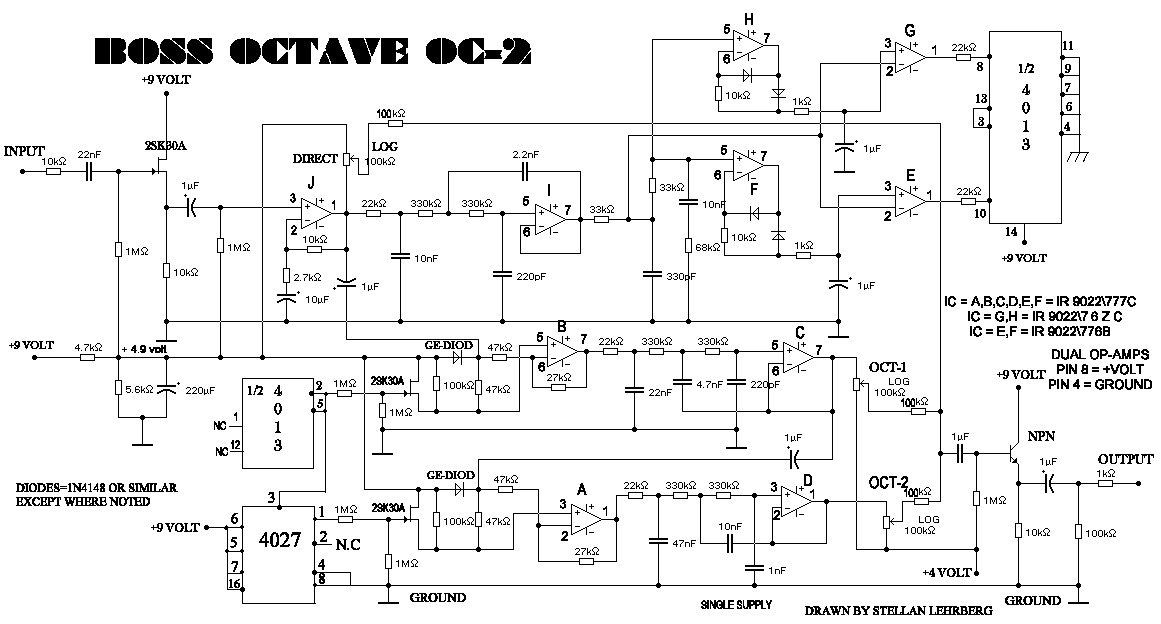Difference between revisions of "OC-2"
(→Phase Inversion) |
(→Phase Inversion: No) |
||
| Line 24: | Line 24: | ||
==Phase Inversion: No== | ==Phase Inversion: No== | ||
| + | |||
| + | If you look at the schematic, you can see that there are a number of amplification stages after Q1 that are taken up by 3 IR9022 opamps. However, you'll also see that the output at pins 1, and 7 for all of J, I , H, G, F, and E are connected and feed back into pins 2 and 5, respectively. This appears to us to be negative feedback, lowering the total amplification, but adding signal stability. If anyone is more knowledgeable about this, we'd love to be updated for the most accurate explanation possible. | ||
| + | |||
| + | The other thing to note is that the 4013 outputs gets split, with its one-octave down signal into the 4027 chip. Afterwards, it should be fairly easy to see that the Octave1 and Octave2 signals run parallel through similar circuit architecture. | ||
{| class="wikitable" style="left; margin-right:20px; background-color:#eeffee;" cellpadding="10" | {| class="wikitable" style="left; margin-right:20px; background-color:#eeffee;" cellpadding="10" | ||
Revision as of 05:09, 21 June 2018
The Boss OC-2 Octave pedal uses the existing note going through it to generate 2 more notes: one octave, and two octaves down, respectively.
Subsequent Boss Octave models include:
- OC-3 Super Octave
Controls

- Knob 1 - "Oct2": Sets the volume level for the signal two octaves lower than the dry signal.
- Knob 2 - "Direct Level": Sets the volume level for the dry signal.
- Knob 3 - "Oct1": Sets the volume level for the signal one octave lower than the dry signal.
- Footswitch 1 - "On/Off": Toggle the pedal on or off.
Bypass:Buffered
Like all Boss pedals, the OC-2 has a buffered bypass.
General Information
This Boss pedal, is like most other octave pedals that came out in the 1980s. It is best played one note at a time, and used either to thicken melody runs, or on solos. Because the OC-2 it was not created as a polyphonic pedal, if more than one note is played, the note tracking circuitry will not be able to keep up. This tends to create sounds that are more like a cacophony than multi-octave chords being played; of course, this may be the sound you're looking for.
Pedal Manual
Phase Inversion: No
If you look at the schematic, you can see that there are a number of amplification stages after Q1 that are taken up by 3 IR9022 opamps. However, you'll also see that the output at pins 1, and 7 for all of J, I , H, G, F, and E are connected and feed back into pins 2 and 5, respectively. This appears to us to be negative feedback, lowering the total amplification, but adding signal stability. If anyone is more knowledgeable about this, we'd love to be updated for the most accurate explanation possible.
The other thing to note is that the 4013 outputs gets split, with its one-octave down signal into the 4027 chip. Afterwards, it should be fairly easy to see that the Octave1 and Octave2 signals run parallel through similar circuit architecture.
| Schematic ID | Electronic Part | Action | Phase State |
|---|---|---|---|
| Q1 | 2SK30A | Does Not Invert | Not Inverted |
| IC-J | IR9022 | Does Not Invert | Not Inverted |
| IC-I | IR9022 | Does Not Invert | Not Inverted |
| IC-H | IR9022 | Does Not Invert | Not Inverted |
| IC-G | IR9022 | Does Not Invert | Not Inverted |
| IC-F | IR9022 | Does Not Invert | Not Inverted |
| IC-E | IR9022 | Does Not Invert | Not Inverted |
| Q2 | 2SK30A | Does Not Invert | Not Inverted |
| IC-B | IR9022 | Does Not Invert | Not Inverted |
| IC-C | IR9022 | Does Not Invert | Not Inverted |
| Q3 | 2SK30A | Does Not Invert | Not Inverted |
| IC-A | IR9022 | Does Not Invert | Not Inverted |
| IC-D | IR9022 | Does Not Invert | Not Inverted |
| Q4 | 2SK30A | Does Not Invert | Not Inverted |
Schematic
Artists
- Additional Sources
